For my first Thanksgiving post, which somehow was both a year ago and almost a year into the pandemic, I gave thanks at the end of the post. With all that’s happened, it seems more appropriate to do this at the beginning of the post instead this year. So I’m going to do that, and deal with this week’s news – the rise in cases, the lockdowns in Europe and all that other stuff – later.
I’ll be working from the previous version, and including almost everything from last year, plus some additions. It is crazy how little this needed to be modified after an entire year, and how many of these are still in the present tense when they could so easily have been in the past tense. Time goes by, so slowly. Keep pushing that rock up that hill, everyone.
So here we go, 2021 edition.
To all the health care workers. Thank you.
To all those maintaining the supply lines. Thank you.
To Ryan Peterson, who worked to get our containers moving again, even if it didn’t end up having as big an impact as we might have hoped. Let this inspire future efforts across the land. Thank you.
To those who worked to manufacture the vaccines as quickly as possible. Thank you.
To Pfizer, Moderna, Johnson & Johnson and AstraZeneca/Oxford. Thank you.
To all those working on all the other vaccine candidates, even if they didn’t work out. Including Sputnik in Russia, and the one in China. And anyone working on all the other treatments, or running any of the experiments or studies, again whether or not your particular effort paid off. Thank you.
To all those working on or expanding capacity for or administering or fighting for the right to do Covid-19 testing, especially rapid testing. Thank you.
To all the essential workers, no matter whether we still call you that. Thank you.
To you, the reader, for being here. Thank you.
To all the commenters, yes all of them. Thank you.
To those who subscribed (Substack version of this post is here). Thank you.
To all those who have thanked me for doing these columns. You keep me going. Thank you.
To everyone who helped push masks, better masks, Vitamin D, zinc, fluvoxamine, airborne transmission, doing things outdoors, proper ventilation and other key information when official sources were saying otherwise. Thank you.
To Robin Hanson in particular, without whom I would not have felt free to start writing these columns. Thank you.
I’d also single out Tyler Cowen and Alex Tabarrok for their work at Marginal Revolution, which has provided lots of useful thoughts and information. And for the rapid grants. Thank you.
To the Covid tracking project, the Covid machine learning project, and all other similar efforts. You’re gone now, but you provided vital information when we needed it most. Thank you.
To the financial security and opportunity to keep me and my family safe, and give me the necessary time to write this column each week. And to the freedom of speech to say what I think each week. Thank you.
To China, South Korea, Japan, New Zealand, Australia and all the other places that, at for a time, beat the pandemic. You showed us it can be done. Regardless of what happened later, you all decided to do a hard thing that mattered, and made it happen. Thank you.
To everyone working to reform or contain the damage from the FDA, CDC, WHO or any other member of the Delenda Est club, or otherwise find ways around regulatory barriers. Thank you.
To the owner of the (still villainous) New England Patriots, who flew a jet in to get protective equipment to health care workers. And everyone else who did what was necessary in the face of banditry, piracy and regulatory obstruction to get people what they need. Thank you.
To those who stood up and called such barriers and enemy actions by their right names. Thank you.
To every politician and public figure and corporate leader, or anyone else, who called upon people to take precautions and also accepted skin in the game and practiced what they preached. Thank you.
To those politicians who did the best they could to help people, based on their model of what would physically help, even if I disagree with that model. Especially strong thanks to those who distributed vaccines and booster shots as widely and quickly as possible in defiance of the FDA and CDC’s recommendations. Thank you.
To those who, instead, had a physical model and then called upon us not to take unneeded precautions, and also practiced what they preached. Thank you.
To everyone doing what they need to do to keep themselves, their families and friends and their communities safe. Thank you.
To everyone doing what they need to do to keep themselves, their families and friends and their communities sane and thriving through all of this. Thank you.
To my in-laws, who helped us get out of New York City in March and have been invaluable keeping things going out here in Warwick. And to our kid’s nanny, without whom disaster would have rapidly ensued. And of course to my amazing wife Laura, for far too many reasons to list here. You all went above and beyond again this year. Thank you.
To my father Solomon, who did his part in all this to help make things better however he could, even if I can’t talk about it on the internet. And for teaching us a legit immunology class over zoom, and helping me understand the science whenever I needed it. And for keeping sane through everything that has happened in that tiny apartment. And for continuing to help me understand things that would otherwise have gone over my head or taken me far too many hours. Thank you.
To my former temporary home in Warwick, New York, thank you. You have exceeded almost all of my expectations. This place is highly underrated.
To my cofounder Kathleen Breitman, and my coworkers Alan Comer, Brian David-Marshall, Corey Burkhart and Paulo Vitor Damo da Rosa, along with many others, as we continue to fight to make the game Emergents a reality. The game is real and the Alpha is beginning. It’s been a long road but we can see the finish line now. Thank you.
I’d also like to once again thank India, clarity, disillusionment, consequence and silence. Especially clarity. But screw frailty.
Let’s not forget the internet. In particular, Amazon, Instacart, Google and Netflix. Couldn’t have done it without you. Thank you.
And also to basically everyone anywhere who modeled the world and is now doing a thing to try and make the physical world better, regardless of whether I think their particular approach is misguided or nonsense. To all the schmucks who think for themselves. To all the live players. You rock. Thank you.
Finally, to everyone I’m forgetting. Thank you too. Comments to thank those I missed are encouraged.
Executive Summary
- Europe is entering lockdown.
- Cases continue to rise.
- Paxlovid remains illegal.
The Paxlovid news got its own update yesterday.
Let’s run the numbers.
The Numbers
Predictions
Prediction from last week: 654k cases (+18%) and 7,500 deaths (+1%).
Results: 593k cases (+7%) and 7,566 deaths (+2%).
Prediction for next week: 620k cases (+3%) and 7,240 deaths (-5%).
This prediction is imposing a -10% penalty for Thanksgiving, as we only get to count reported deaths and cases rather than the actual situation. A lot of the uncertainty here is about how much the holiday will deter testing and reporting, including reporting of deaths.
I would presume that Thanksgiving itself has only a small effect on the course of the pandemic, and also presume that this effect won’t yet show itself in next week’s data, or will be overwhelmed by the reporting drop.
Deaths

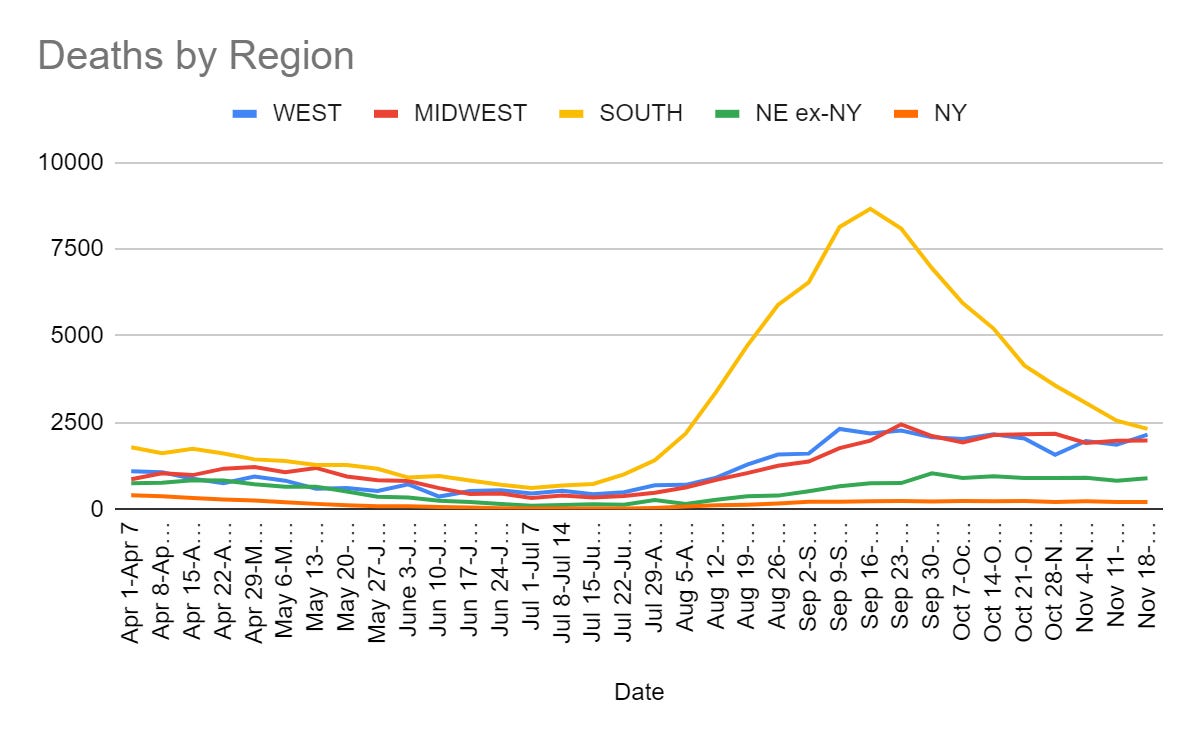
A total of 7,566 people died this past week. Since Pfizer’s announcement of results on November 5, about 20,000 people have died in America of Covid-19.
With cases rising, deaths will follow until the approval and widespread use of Paxlovid. At which point they will continue to follow at a much slower rate.
Cases

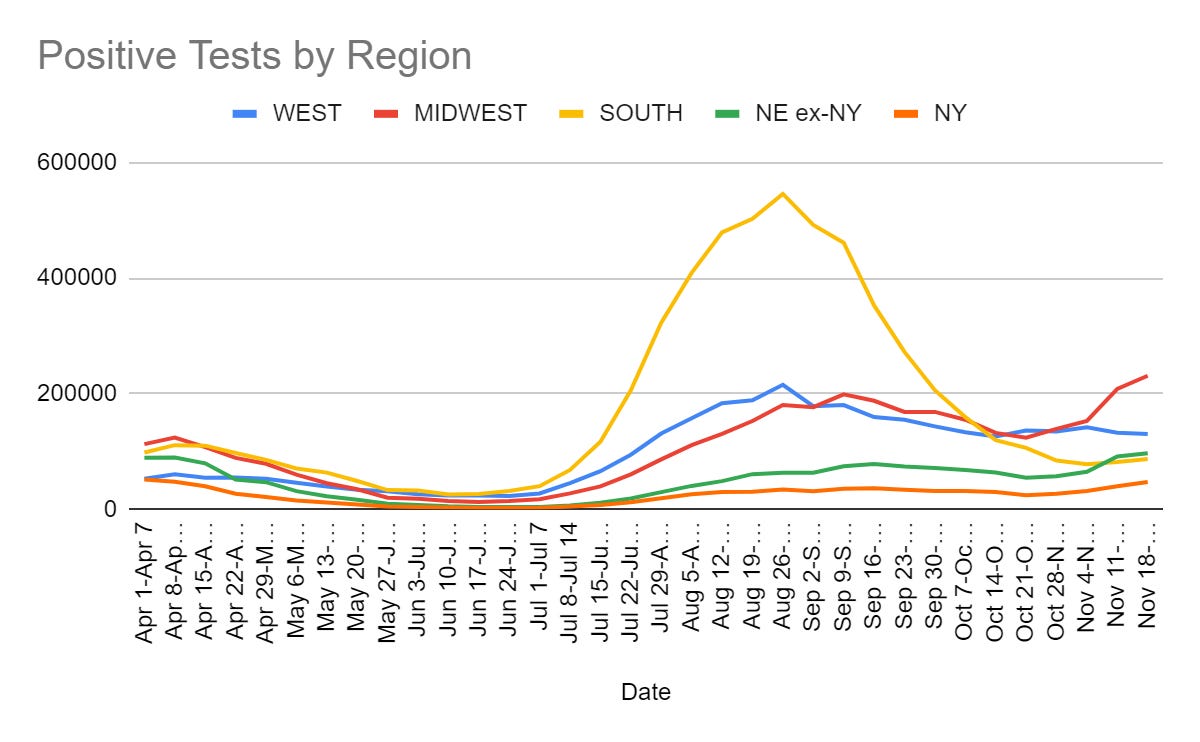
Cases are up, including unexpectedly up in the South, but these numbers are good news as reasonable expectations after last week were for things to get worse faster than this. Given deaths were right on path, it’s unlikely the holiday had an impact on reporting yet, so this is a large reduction in my estimate of how rapidly things are getting worse.
This is especially good news because the situation in Europe has escalated so quickly, and because they have responded with lockdowns. That raises the chance that politicians here might think further restrictions, up to and including lockdowns, might be a good idea when they see the wave continuing, and we very much need to avoid that for many distinct reasons.
Vaccinations
Bloomberg still calls this the ‘path to immunity’ but at this point it’s clear that things do not work that way on the national level. They only work that way for an individual. It’s still excellent news to see the rise in vaccinations, even though it is driven by less important child vaccinations rather than adults changing their minds.
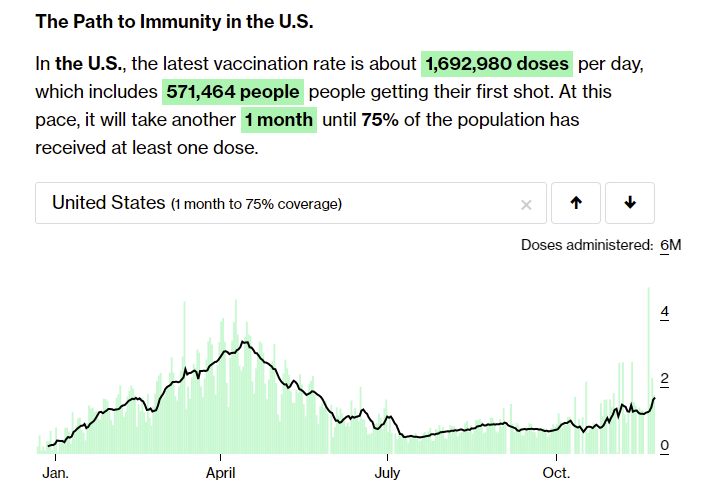
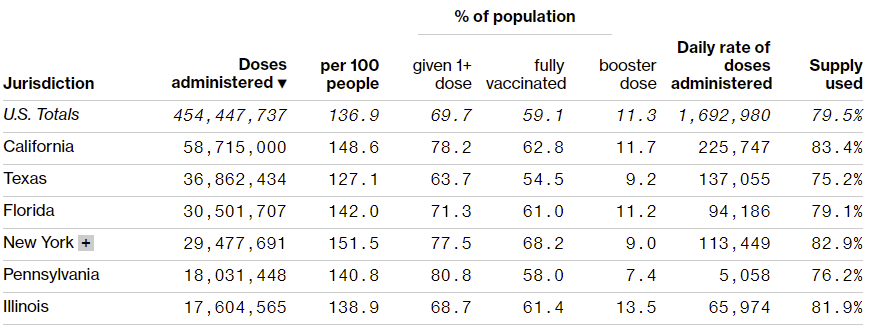
A child vaccination rate graphic showed up in my inbox so here it is:

In total, the CDC showed that 2.84 million young children, or 10% of that population, have received at least one dose of a Covid-19 vaccine.
Booster Boosters
The story of Covid-19 boosters, which have now been given to ~11% of the adult population, seems to broadly be something like this:
- Boosters seem like an obviously good idea.
- Biden declares we’re going to offer boosters.
- FDA/CDC get upset, demand that we respect their authorita.
- FDA/CDC begrudgingly approve boosters, but only for the sufficiently vulnerable/worthy of being protected from Covid-19.
- That technically includes most people, but most people don’t know how the rules work.
- A lot of people realize that the technical rules don’t matter at all, what you have to do to be worthy is check a box.
- States start deciding this is stupid and opening up boosters to all.
- It turns out that yes, they can do that.
- FDA/CDC fold and agree to boosters for all.
- They draw a distinction between who ‘should’ get a booster, and who graciously ‘can’ get a booster.

Here’s a FiveThirtyEight discussion of the situation. Which includes this:
betsy: I agree with you, the communication challenge does not help. … I keep thinking about that Kaiser Family Foundation poll saying 4 in 10 vaccinated adults don’t know if they’re eligible for a booster.
maggie: Hell, I’ve been confused about that.
cwick: It sounds like all three of us are in that 40 percent! And maybe MORE people shouldn’t know if they need it.
It also includes this, which seems like a good summary of one framing a central thing happening:
Listening to the advisory-committee meetings, I noticed that there seems to be this tension between the scientific experts who want to make robust evidence-based decisions — and the sense that, here in the U.S., our overall pandemic strategy is basically “vaccinate our way out of the pandemic.”
When I hear the term ‘robust evidence-based decisions’ in contexts like this I mostly interpret it as code for something one might slightly uncharitably call ‘this would be a Potentially Blameworthy Action and counts as Medical, and thus requires an isolated demand for rigor, and must prove itself to be overwhelmingly correct based only on properly formatted evidence gathered in Officially Approved ways.’
This thread covers the ACIP meeting about the topic in detail.
Did you know boosters work? As in hot damn check out this chart?
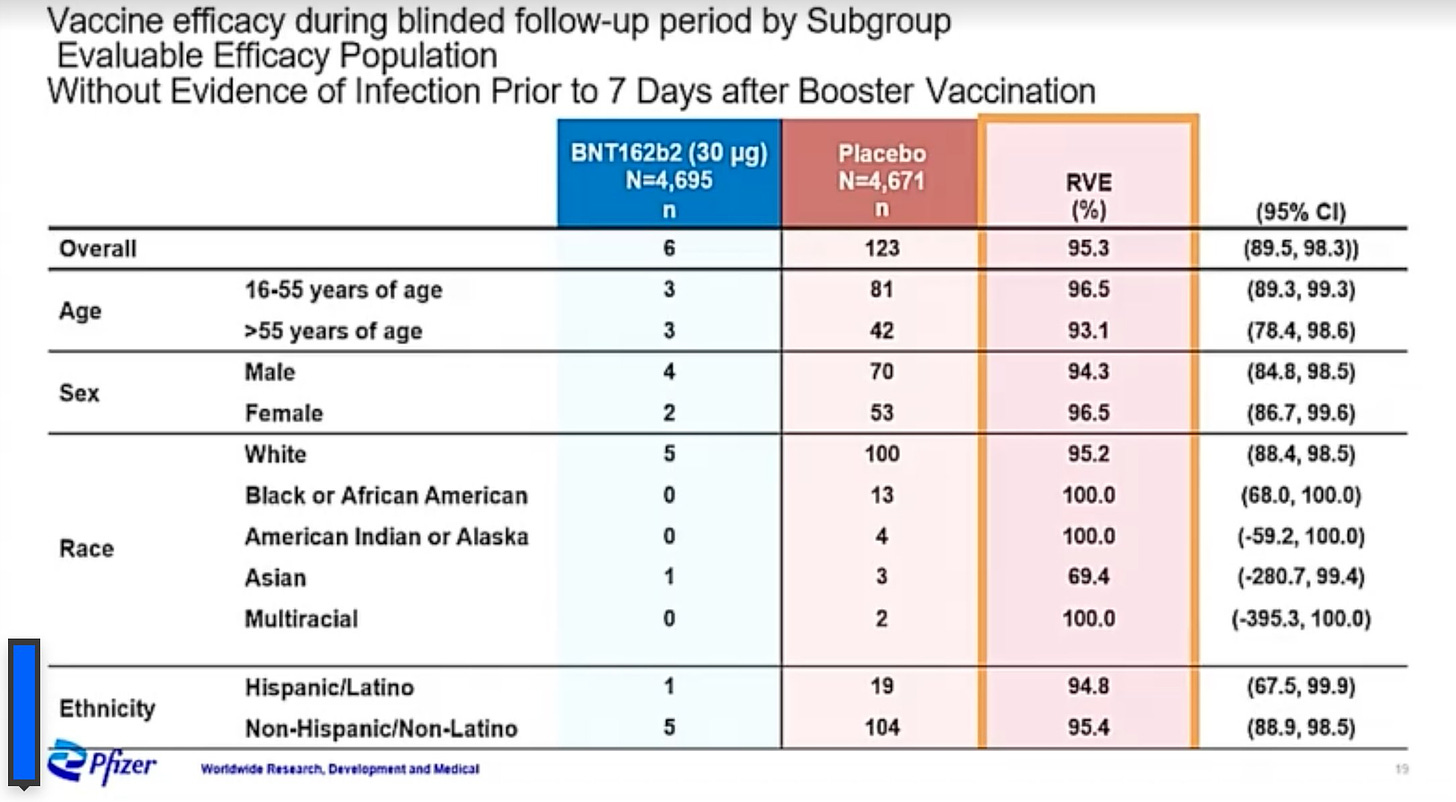
I mean, yes, you did know, but a reminder, and especially that the comparison is to an already vaccinated control group, seemed worthwhile.
For those wondering about the magnitude of short term side effects, here’s the data for Pfizer:

Side effects that make people paranoid watch, why are we still discussing this endlessly and potentially crippling our civilization edition:

It seems that one core argument was that they would have liked to reserve prevention of Covid-19 for only those sufficiently worthy, but if you do that the sufficiently worthy aren’t sure if they’re worthy enough and miss out, so we’ll have to compromise and let everyone prevent Covid-19?

The new motions allowing everyone to get a booster passed 11-0, and also were noted to ‘have the support of all states’ so that’s kind of another 50-0 vote. Either this is a The Death of Stalin situation where once it’s going to pass everyone must vote for it, which wasn’t true for past votes, or we managed somehow to hold out on this until we had universal agreement, in which case it’s an interesting question what took this long.
A lot of the problem seems to be arguments over ‘may’ versus ‘should.’ Right now that seems like a distinction without a difference, but some are annoyed that we’re not telling young people the obviously correct thing that they should get a booster, while others are concerned that if the word should is used it could lead to mandatory boosters. Once again, that which is not mandatory is forbidden and that which is not forbidden is mandatory and all that. The flip side is ‘if we don’t use the word should then the young people won’t get the vaccine.’
Plus there’s an unsaid contradiction of the argument that of course we should be making vaccine decisions in part based on their social benefits, and we’re going to blame insufficiently vaccinated folks for the pandemic and threaten insufficiently vaccinated populations with both individual and collective punishments, with the fact that officially all decisions can only be made on the basis of individual risks and benefits under extreme risk aversion.
Vaccine Mandates
If you want someone to do something you can:
- Reward doing it.
- Punish not doing it.
- Force them to do it.
Sufficiently large rewards and punishments constitute force. If you are going to use such force, it is better to be explicit that you are doing this, for several reasons.
- It’s important that we live in a world where we know what’s going on, let the facts enter common knowledge and people call things by their right names. Here’s Taylor Swift taking ten minutes to say that in a different context.
- Choices are bad. When you give people the illusion of false choice, you’re pretending you’re not forcing them to do it. That makes them feel bad about choosing to do it and agonize about the ‘decisions’ being made and what has been lost, and makes them feel like it is in a way ‘their fault’ or their choice.
- There’s a lot of lost time and stress and fighting over exactly what’s happening, which would be avoided if you came out and said what you were doing.
- People can see what you’re doing, and that you’re lying about it. Which pisses them off, as many of my commenters have pointed out in various ways.
- People can also see that you consider your authority illegitimate. If you could mandate the thing outright, you would have, but you didn’t, so you can’t. Which means you lack the legitimate authority to do the things you’re doing. If the authorities tell us they are illegitimate, why shouldn’t we believe them?
Thus, I am far more sympathetic to an actual full-on outright mandate than I am to doing various end runs like using OHSA. That particular end run ran into legal problems, and any enforcement seems to have been abandoned at least for the time being. Enforcement was never the point, since the authority was illegitimate. The point was to give employers cover to impose mandates they wanted to impose anyway.
I am also far more sympathetic to requiring vaccinations than I am to requiring lots of other restrictions that I consider much bigger costs, much bigger violations of liberty (as in, you can’t go outside) and which are much less effective.
Do, or do not.
Last week regions of Austria instituted a lockdown on the unvaccinated. Either get vaccinated, or you can’t leave your house without an Officially Approved Excuse. That seems like it is clearly over the line. Then two regions extended it to the unvaccinated as well, then the country went into full lockdown.
Alongside the lockdown, Austria has come out and said it. Vaccines for everyone. To me, this obviously comes well before issuing a nationwide lockdown and telling people they can’t go outside except for daily needs, with no end in sight. To me, if you issued a lockdown, it means you should have already issued a full vaccine mandate earlier.
I would not be issuing a lockdown regardless of how bad things get, and I’d be leave-the-country level furious if I lived there, but it would be that much crazier without a full vaccine mandate. I do understand their position, especially given Paxlovid. More on the situation there in the next section.
The Army bans the unvaccinated from reenlisting, being promoted or other ‘favorable personnel actions.’ That last one risks giving the game away. The full deadline for soldiers to get vaccinated is December 15.
If you get vaccinated, The New York Department of Corrections will generously let you have facial hair. Reactions differed.


The incentive is you get to be protected from Covid-19? What about guards who didn’t want facial hair? What about the ones who could use it as an excuse before and now can’t, and are worse off because choices are bad? Not everything has to work on everyone in order to be a good idea? Have we tried paying cash? Have we tried paying more cash? Have we tried you’re among people who are there at gunpoint so it’s kind of a job requirement, thanks? From context I’m guessing no.
The Return of the Lockdowns
As of Sunday morning, as per Bloomberg, here’s where Europe was:

It has since spread considerably further. The examples below are doubtless incomplete.
Austria is in full lockdown, and I understand their position. At the time the lockdown was instituted, Austria’s daily case count was unprecedented, over one person in a thousand each day, and rising rapidly.
Slovakia has locked down. Italy is considering locking down the unvaccinated.
Some signs of resistance, warning shots fired at protesters in Rotterdam, at least two people shot.
Germany, where things are not as bad but where cases are also higher than ever before and rising rapidly, is calling this a ‘national emergency’ and has now also pulled the trigger on a full lockdown.
What Germany doesn’t seem to be doing is treating this as a sufficiently urgent emergency to ensure that the unvaccinated have reasonable ways to get vaccinated, as per this comment from last week’s post.
German here. I live in this weird reality where all the media are scapegoating the unvaccinated, yet when I walked into a doctor’s office last week fully expecting to get a shot in my arm right away, they told me what they had already told me in summer: “No, you have to get on a waiting list of about 2-3 months.” Quickly looked up online if there’s anything else officially available in my city, also no. It seems to me that if you want to scapegoat the unvaccinated for all your pandemic mishandling and overreaction problems, you should at least, ya know, offer them vaccines.
This isn’t a supply issue. Others replied that appointments are easily available in Berlin, but that’s several hours away. Ensuring quick and easy vaccination appointments does seem to me like the least you could do if you’re going to be declaring national emergencies and scapegoating the unvaccinated.
So more detail from another comment, mumble mumble something incentives something something not paying enough money mumble something revealed preferences:
Only German sources (see below) and anecdotal experience:
1.My roommate was in the same position as Anon but got an appointment for his first dose in less then two weeks (was there last week).
2. Regarding incentives: Doctors got 20€ per administered shot, health minister raised it last week to 28€. I don’t know if it’s financially viable to do vaccinations for doctors. The doctors I know (family friends) are giving out vaccinations, but the majority of their work time is for “normal doctoring”. Waiting times around 1-2 months aren’t uncommon at regular doctors.
3. In my city, Aachen a medium sized city, there is one place where everyone can get vaccinated (1./2./3. shot) without appointment. It’s open 12:00-20:00 thought the waiting times can get quite long after regular business times. (Its in the shopping center where i buy my groceries, so i see the queues several times a week. There are 170 of these centres in Germany.
4. Also there are “vaccination busses”, mobile opportunities to get vaccinated without appointment in Aachen and surrounding cities. Around 700 of these are driving around Germany.
That does not sound to me like the appropriate response to a ‘national emergency.’
Yet they claim to be taking the matter seriously, as you see here.
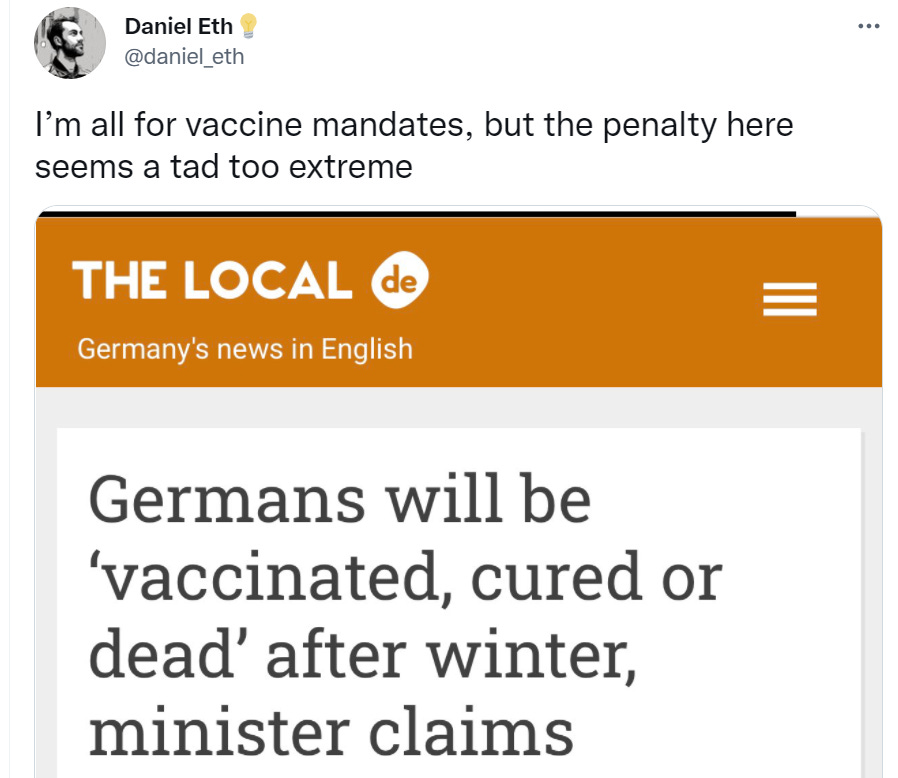
If you look at deaths rather than cases, even if you take into account the time lags, things look much less dire. Vaccinations work, and also our procedures have improved.
There’s still quite the large surge, and vaccination does not seem to be a sufficient defense:
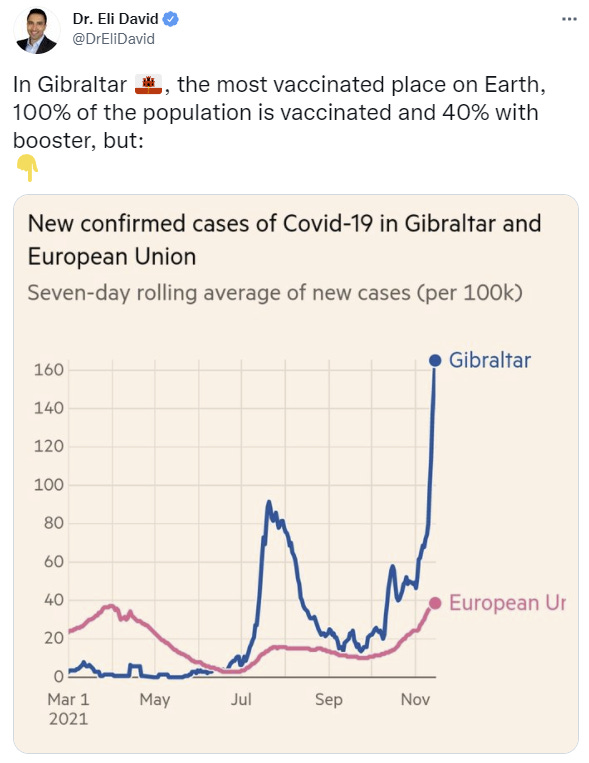
There’s a lot of deeply stupid takes about how this means vaccines ‘don’t work’ but it does mean that they by themselves, including with a 40% booster shot rate, are insufficient at containing infections. Which is a much less scary prospect than without the vaccinations, but still matters, even if everyone is vaccinated and therefore there won’t be that many deaths.
The replies trying to ‘support’ vaccinations are pure clown-makeup-meme, you see vaccinations were never supposed to prevent infections or anything, ‘the basics of science’ means repeating the Party Line, can such people please stop helping.
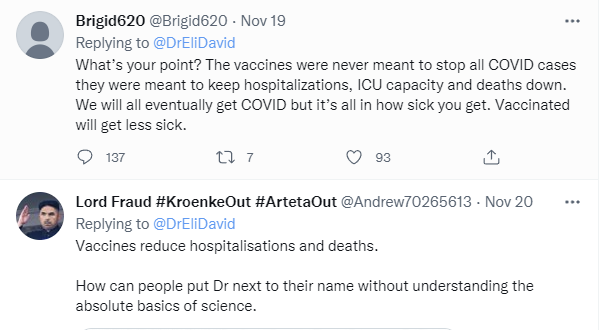
The timing of these lockdowns is interesting in light of Paxlovid and the new vaccine mandate. Otherwise, without a new effective drug or a lot more vaccinations on the way, what are you hoping for when you lock down?
Here it’s clear what you are hoping for. If the policy works, in two months a lot more Austrians will be vaccinated and a new drug will be available. Spread will come down a lot, and for those who still get infected, death rates will drop dramatically. So rather than kicking the can down the road, this could actually do what a lockdown is supposed to do, and get the corner turned permanently.
On another note and as your periodic reminder, Andrew Cuomo was the worst. His successor Kathy Hochul has the great advantage of not being Andrew Cuomo. In an attempt to make up for that head start, here she is threatening collective punishment via new restrictions if cases don’t drop.
ALBANY, N.Y. (AP) — New Yorkers in upstate communities seeing upticks in COVID-19 cases could again face more pandemic restrictions if infection rates fail to drop, Gov. Kathy Hochul said Tuesday.
The Democrat later tweeted a note of optimism: saying she’ll direct the state health commissioner to relax rules like masks in schools if New York gets “through the holidays without a spike.”
Hochul didn’t outline any specific COVID-19 protocols she could put back in place, or how she would define a decline or spike in COVID-19 rates.
But she said she’s troubled by vaccine holdouts and signs of rising COVID-19 cases in parts of western and central New York.
“At some point if the numbers don’t start on a downward trend, we’re going to have to talk about larger protocols,” Hochul said. “I truly hope the community at large will listen to this because it doesn’t have to be this way.”
I do give her credit for pretending to being symmetrical, and offering to relax rules like masks in schools if the impossible happens. The ‘no winter spike’ ship has sailed. It still gives hope for the future. Similarly, this is presumably an empty threat along with that empty promise. It is an unspecified threat to impose unspecified restrictions under unspecified conditions, if the people let her down and don’t ‘listen.’ You see, if the same thing happens in New York that happens everywhere else that is similarly cold, it must be the fault of the people, who ‘don’t listen.’ Thus they then must be punished.
I am curious what would happen if she made good on her threat. Buffalo has reinstituted a mask mandate.
How much would people tolerate at this point?
Non-Covid Local Aside: Come On Step Inside, You’ll Be Taken For a Ride
In non-Covid Hochul news, here she is bragging that thanks to that sweet, sweet federal cash, we’re going to build out the Second Avenue Subway another 29 blocks for the low, low (estimated! hoped for!) price of $6 billion dollars, or slightly over $20 million per city block, or $2 billion per subway stop that will be used, two of which are new and one of which will be a connection. It’s expected to serve 100,000 riders daily, at the (again, low low low!) cost of $60,000 per daily rider.
If we reasonably estimate that a daily rider gets marginal value of $5/ride, that’s $500k/day in value, or $182 million/year, so a 3% yearly return on investment. At current borrowing rates, plus a fiscal multiplier, that’s at least reasonable. Could be worse if this is mostly substituting from otherwise available 456 trains, but if this substitution substantially improves conditions on the 456 line, which were usually at capacity in an unpleasant way in non-pandemic rush hours, or this substantially improves traffic uptown and on the FDR, you could potentially generate a lot of value. When I was commuting on the 456 I’d have paid a decent amount extra to have better conditions. So looked at this way, the project isn’t a slam dunk at this price, but if you somehow presume it will finish within or near budget it isn’t obviously crazy.
Plus, ‘at the heart’ of it all, this will promote ‘transit equity.’ Quick, someone who understands real estate, solve for the equilibrium.
Except there’s a problem. The population of all of Spanish Harlem is 116,000 people. How are 29 blocks of subway tracks and 2-3 extra stops going to generate 100,000 additional daily riders?
Think of the Children
Speaking of collective punishment, when will our children be able to take their masks off? For a while now, the question has been whether there is an end at all, or there is permanent midnight. Thus, things are so gloomy that almost any endpoint, for any restriction, provided it will be adhered to, feels like good news. I also try to adhere to the principle of not going after those who take positive action because they didn’t do enough, lest we fall prey to the Copenhagen Interpretation of Ethics and punish both good behavior and action in general.
Despite that, it’s not like Michael Blume is wrong here, there is a limit.
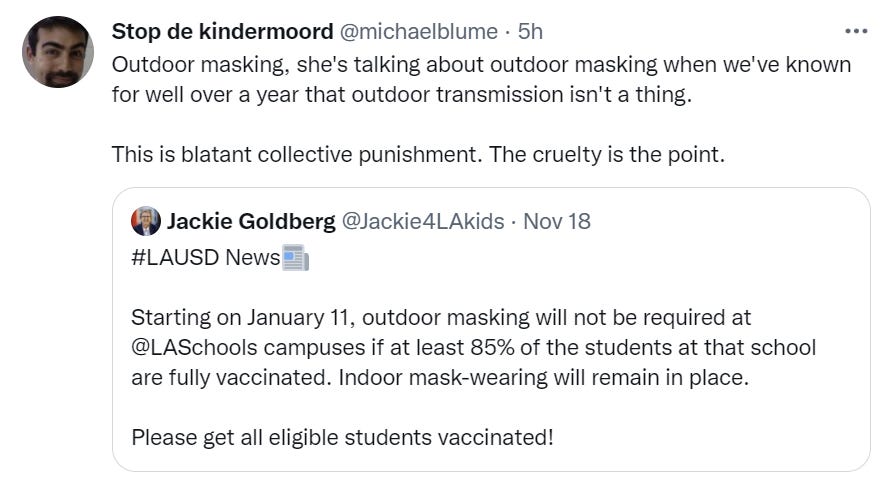
I wouldn’t go so far as to say outdoor transmission ‘isn’t a thing’ but having an outdoor mask mandate is still rather ludicrous. And there’s no end in sight for the indoor mandate that will be in place for most of these children’s waking hours. Young children, mostly vaccinated, doesn’t matter. Permanent midnight. Holding the release of even the outdoor mask mandate hostage via collective punishment to force child vaccinations is exactly what it looks like. And yes, these people don’t actively want children to suffer in general, but despite that, no, exactly because of that, the cruelty is the point. If you are cruel, it shows you care about being part of the coalition more than you care about not being cruel to children. Otherwise someone might think you cared about not being cruel to children.
FiveThirtyEight’s original headline (hint: always look at the URL) is We Polled Kids About the Pandemic, They’re Doing Surprisingly OK. They’ve since noticed that ‘surprisingly OK’ in context is more a statement about what we were expecting than it is about how the kids were doing. It’s still good news. The kids aren’t great, but this was better than my expectations. Maybe they’re mostly alright.
They are, however, still eating lunch outside on the concrete ground. Come for the disbelief that kids would do this and the son who ‘sits with the kids who have allergies because they get a bench,’ stay for the ‘it’s much safer so I don’t see the problem’ at the top of the comments.
In Other News
Maybe it’s not the lack of heat, it’s the lack of humidity? The theory is that large drops in humidity and the resulting adjustment periods cause physical dynamics that make viruses spread, and that’s why Covid-19 is ‘seasonal’ but its patterns look weird. Huge if true! It seems like there are enough other data points that we should be able to confirm or deny the hypothesis. Anyone want to give it a systematic shot?
In Paxlovid news since my post yesterday, a suggestion that Paxlovid won’t have much impact because America can’t get a pill to people within three days.
But it might be difficult to get the drugs outside a clinical trial setting. Depending on the particular patient, it could involve four individual steps: recognizing symptoms, receiving a positive Covid-19 test result, being prescribed an antiviral by a doctor, and picking up the pills at a nearby pharmacy.
Each step could prove difficult, Gaffney said, beginning with the challenge of recognizing symptoms during winter, when early signs of Covid-19 might be easily written off as a cold, flu, or allergies. Even if patients do quickly suspect they have Covid, diagnostic tests are still sometimes hard to come by. Many of the patients who test positive won’t have primary care physicians. And perhaps worst: The antivirals are ideally taken just three days after symptom onset, meaning the four-step process can’t face any setbacks.
Of all the challenges patients will face when seeking the antiviral treatments, the lack of access to efficient testing is by far the largest.
The FDA of course is also fully responsible for our lack of testing availability. And it’s also responsible for the system that requires the appointment to get the prescription, and the pharmacy to fill it. It’s not like this wouldn’t entirely be a systemic failure where the government forbids people from access to life saving medicine, it’s only a slightly different mechanism.
This isn’t three days from infection. That’s hard. This is three days from symptoms. That should be trivial. There exist cheap rapid tests that take fifteen minutes.
Thanks to the murderous madness delaying Paxlovid, we have a month to prepare. There is zero excuse. FIX IT!
Instead, not the faintest whisper of doing anything but nothing.
I can only imagine a researcher at Pfizer, having now given us first a safe and effective vaccine and now a safe and effective treatment pill, screaming “what does it take? Literally what the f*** do you want from us?” at the top of their lungs at no one in particular.
If we are showing little interest in solving these problems, even now, then are we actually interested in stopping people from dying?
Meanwhile, if you’re in need of a bouncer today at Thanksgiving dinner as you demand negative Covid-19 tests, despite the availability of boosters, maybe it’s not about stopping disease?
CDC data on vaccinations is a contradictory mess, which they were notified about weeks ago and also says on-their-face nonsensical things like a 99.9% vaccination rate among seniors in some areas. I do not think the CDC is making deliberate errors in its data, but any reasonable set of sanity checks would have found this, as would keeping an eye out for people claiming there are errors.
A detailed analysis claims to show that our social distancing efforts were actively counterproductive and misaimed, reducing activity in all the wrong places and closing enough locations to close to overcrowd those that remained open. I have quibbles with the details, but given that this doesn’t include outdoor activities, it’s worse than that.
Eliezer Yudkowsky’s current epistemic state with respect to the origins of Covid-19 updated significantly this week, article here. The key questions to ask here are what your prior was before this information (if possible please do pick a number) and then what is the likelihood ratio on this new information? How often does it happen in the worlds where the origins of the virus involved a lab versus didn’t involve a lab?
Richard Hanania notices that he is surprised by the variation in response to Covid-19. I agree that given other things are as similar as they are that it was surprising that the particular responses in question varied so much. The imposition of mask mandates and shutting down of life varied greatly from place to place, often but not always in line with partisanship, and this didn’t change people’s votes much on either side.
I strongly agree that we learned people are more conformist than we thought, that partisanship is stronger than we thought, that extreme government actions can be normalized quickly, and that elected governments on both the state and federal levels have far more rope to do things they feel like doing than we expected, no matter what the laws technically say they’re not allowed to do.
Red state America is the outlier where there was real pushback and real skepticism of elites. While that often got in the way of prudent measures, and advocates of such things often were spouting nonsense and being quite annoying about it, this also got in the way of lots of importantly imprudent measures. On net, it’s now safe to say that refusing to quietly play along on the margin came out ahead. We will need a healthy amount of such skepticism going forward, if we are to retain some semblance of our freedom and continue believing that we might have rights.
What I also find even more curious than the variation in policy decisions regarding restrictions is the conformity and uniformity of other decisions, especially those that prevented us from getting access to information. Things like (and by all means add ‘with notably rare exceptions’ in places where there were notably rare exceptions):
- Everywhere, elites agreed what the current Official Facts were, and what was misinformation. Then the facts changed, and they changed everywhere, as did what counted as misinformation.
- Everywhere we were not allowed to conduct experiments to find out how Covid-19 worked, running only the same handful of experiments that were standard enough to be permitted. We still don’t know many basic facts.
- Everywhere we were not allowed to do challenge trials to accelerate vaccine development or test treatments. Everywhere approved the vaccines at roughly the same time with roughly the same level of required evidence, with only minor variations. No one gave even a first look to the nasal vaccine, so it was never tested and we’ll never know if it works, and so on.
- Everywhere treated the FDA and CDC, or similar local authorities that kept to the same official lines, as the arbiters of not only truth but also of what was permitted, and acted as if those decisions everywhere were sane rather than crazy, although there was some variation in how badly various things were botched.
- Everywhere imposed the same types of restrictions in roughly the same order. Almost no places started ‘following the science’ and switching up the order as we figured things like ‘outdoor transmission mostly isn’t a thing.’ The biggest variation was to what extent various places continued to place an emphasis on surfaces, ‘deep cleaning’ and hand washing after they were known to be not important, but that was mostly private action from the start for both logistical and psychological reasons.
- Everywhere rolled out the vaccine via the same prioritization methods, and mostly stuck to the distributions from the initial studies, although a handful of places instituted first doses first, and some did mix and match faster than others, but that shows how low hanging the fruit had to be in order to be considered at all. No one did fractional dosing.
- Everywhere used six feet or two meters as the social distance rule despite it being an arbitrary number.
- Everywhere acted as if the lab leak hypothesis was a conspiracy theory.
- Everywhere treated variolation (deliberate infection in order to build immunity) as not being a serious proposal. It’s now clear it would have been a big win.
Not Covid
Via Marginal Revolution, a news report that a lot of supermarkets are putting filler stock on their empty shelves to pretend that they aren’t out of large numbers of products due to supply chain issues. A question that I haven’t seen asked is why they can’t fill those shelves with different products they don’t normally carry, but which might actually sell. In normal times, as I understand it, there are lots of brands that would love to get onto supermarket shelves, so much so that they often pay for placement. Surely a deal could be reached here to give those alternatives a shot, and see what happens?
Itai Sher thread (via MR) about how much deference and trust we owe ‘experts,’ especially when this is defined by ‘I wrote a book about a thing and convinced someone to publish it.’ My position is essentially ‘some benefit of the doubt on fact questions unless we have reason to be suspicious (in which case trust but verify, followed if needed by don’t trust and still verify), but for conclusions or generalizations very little unless you can do a lot better than having written a book or having the right degree or faculty/government position.’
The Lighter Side


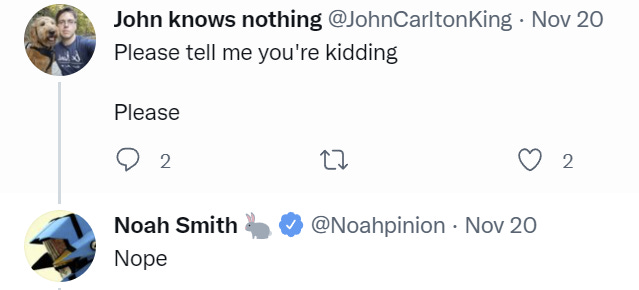
Who will stand up to these dastardly muppets?

No idea. It’s an ongoing problem. Who will stop the count?
Then again, I still don’t really know what I was expecting?

Other times, I do know what I’m expecting.
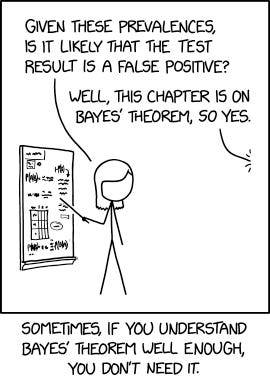
Full credit. This is how this works. This is exactly how all of it works.